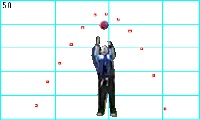Stefan Maibücher, Alexander Solms

Inspired by the recent project "Acoustic Experiments with a Sound Card", we wondered whether one could also do physics with a video card. A video recording is essentially a sequence of a certain number of images per second. Therefore, it can be used to study moving objects, but also photos can be extracted.
In order to realize our project, we bought a simple video card (for DM 250), which allows uncompressed videos to be recorded by a computer. More expensive video cards that record higher quality compressed videos were out of reach as they cost at least DM 800.
We used the software Asymetrix DVP Capture 4.0 to cut our videos and to change their format in order to keep their size as small as possible. Small AVI video files were needed so that they could be copied onto a floppy disk and viewed by students using an ordinary computer with Windows 95.
We used the shareware Galileo for video analysis, which we got from the CD that accompanied c't magazine in May 1997. Galileo allows the extraction and graphical representation of measurements from AVI-videos. Such graphs can be superimposed with mathematical functions in order to compare experiment and theory. We have illustrated this with several of our own examples.